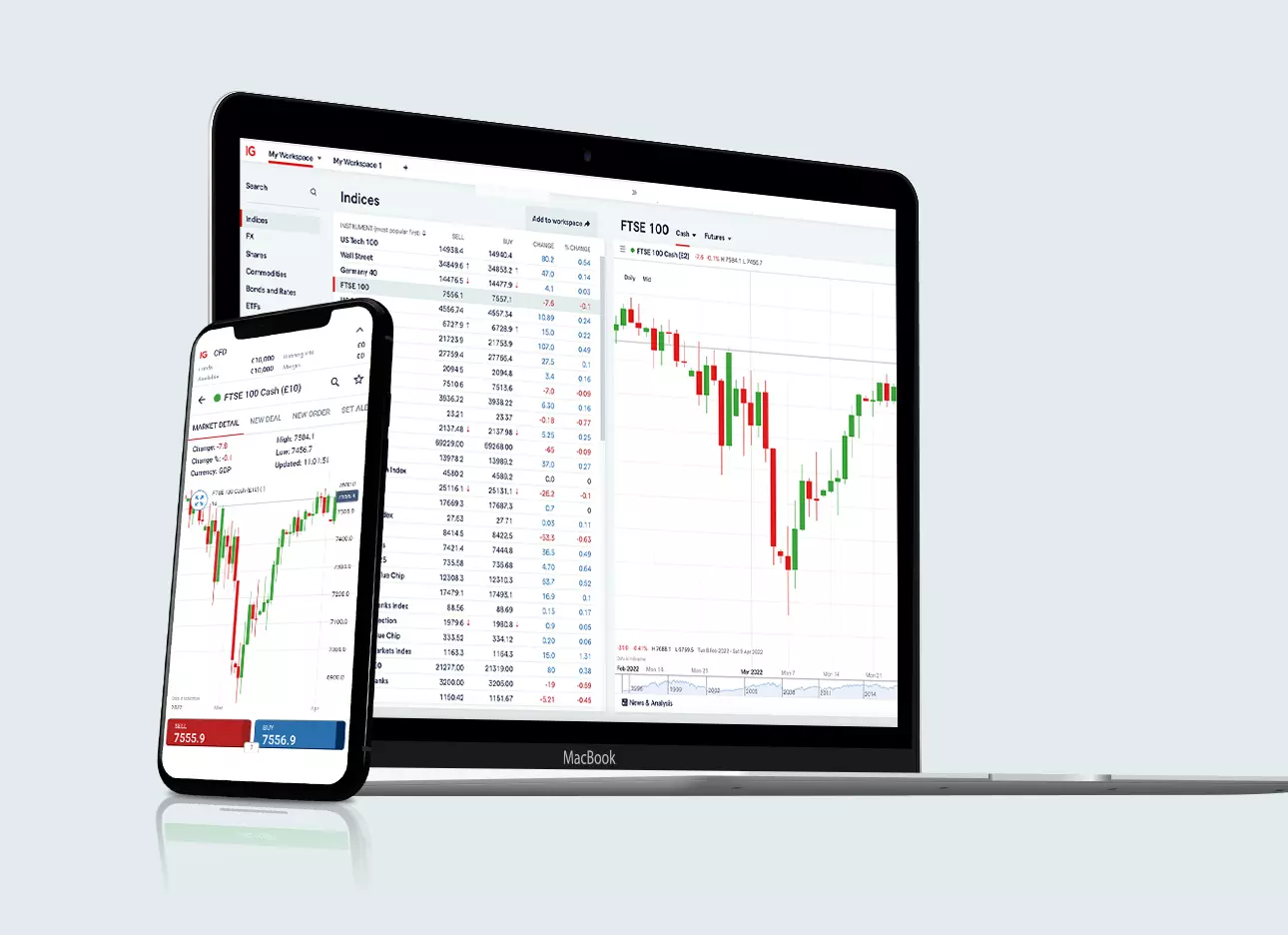What is leverage?
With leverage, you can get a much larger exposure to the market than the amount you deposited to open the trade. Leveraged products, like contracts for difference (CFDs), magnify your potential profits and losses. Here's everything you need to know about how leverage works.

Leverage is a key feature of CFD* trading and can be a powerful tool for you. Here’s a guide to making the most of leverage – including how it works, when it’s used and how to keep your risk in check.
*CFDs are leveraged products. CFD trading may not be suitable for everyone and can result in losses that exceed your deposits, so please ensure that you fully understand the risks involved.
What does leverage mean in trading?
Leverage in trading enables you to open a position worth much more than the money you deposit. For example, you might be able to multiply your position size by 5, 10, 20 or even 33x the amount of your initial outlay.
When trading, you’re predicting on the price movements of markets and underlying assets, rather than owning these assets outright, in the hope of making a profit. When you do this with leverage, it means that most of the capital is put up by your broker, with you putting down a deposit worth a fraction of the trade size in order to open a larger position. There won’t be a charge for how much leverage you use – whether 5x or 20x your deposit amount.
So, for example, you may open a trade on Tesla stock worth $1000, with a deposit of $200. Your broker would put up the other $800 initially, enabling you to open a position 5x greater than your initial outlay.
How does leverage work?
Leverage works by using a deposit, known as margin, to provide you with increased exposure to an underlying asset.
Essentially, you’re putting down a fraction of the full value of your trade. Although you’re only paying a small percentage of the full trade’s value upfront, your total profit or loss will be calculated on the full position size, not your margin amount.
Your total exposure compared to your margin is known as the leverage ratio.
Understanding the difference between margin and leverage is crucial:
- Margin is the deposit you put down (e.g., $200)
- Leverage is the multiplier effect (e.g., 5:1 ratio)
- Exposure is your total position size (e.g., $1,000)
This means margin and leverage work together - your margin requirement determines how much leverage you can use.
Leveraged trading: an example
Let’s say you want to buy 1000 shares of a company at a share price of 100 cents. To open a conventional trade with a stockbroker, you’d be required to pay 1000 x 100 cents for an exposure of S$1000 (not including any commission or other charges).
However, with leverage, you can pay a fraction of this cost upfront. If the margin amount was 20%, you’d pay just S$200 to open a position worth S$1000. Both your profits and losses would, however, be calculated on the full S$1000.
If you went long on your trade and the company’s share price goes up by 40 cents, your 1000 shares are now worth 140 cents each. If you close your position, then you’d have made a S$400 profit – double your initial margin amount of S$200.
The reverse would be true if you went long and the share price dropped by 40 cents, you’d have made a S$400 loss – double your initial amount paid. So, there’s substantial risk of profits or losses outweighing your margin amount.
Leveraged

How unleveraged trades work:
When opening unleveraged positions, you’ll need to commit the full value of your position upfront. For example, let’s say you want to buy 10 shares of a company at a share price of 100 cents each. To open a conventional unleveraged trade, you’d be required to pay the full S$1000 upfront.
This means more initial capital outlay, but it also caps your risk. That’s because, unlike leveraged trades, the risk of loss with unleveraged trading is equal to the amount paid to open the position.
So, in our previous example, the potential for loss is also limited to the S$1000 you paid for the position. Although you’d only paid S$200 to open a position of the same size with a leveraged trade, your profits can appreciate as much as the share price does, but you can only lose as much as you initially paid to open the trade – so S$1000 at the most.
Remember, with us you can only trade derivatives via CFDs.
Unleveraged

What leveraged products can you trade?
Most leveraged trading uses derivative products, meaning you trade an instrument that takes its value from the price of the underlying asset, rather than owning the asset itself.
With us, you can trade derivatives via CFDs.
Contracts for difference (CFDs)
An agreement with a provider (like us) to exchange the difference in price of a particular financial product between the time the position is opened and when it is closed.
There are lots of ways to trade these leveraged products with us. Though they work in different ways, all have the potential to increase profit as well as loss. These include:
- Spot trading: open cash positions on the spot
- Futures: open longer-term contracts for a future date
- Options: buy contracts that give you the right, but not the obligation, to buy or sell an asset on a future date
Which markets can you trade using leverage?
Some of the markets you can trade using leverage are:
- Shares
With us, you can trade over 10,000 international shares, including blue chips like Apple and Meta - Forex
The world’s most-traded financial market – we offer over 90 currency pairs, from major to minor and even exotic pairs, 24 hours - from Monday to Friday - Indices
We offer over 30 indices around the world, with spreads from just 1 point - Commodities
Trade 30 major commodities markets – including gold, oil, silver, natural gas and sugar – at their current market price with no fixed expiries - Exchange traded funds (ETFs)
We offer over 2,000 ETF markets for you to gain broad exposure to speculate on indices, industries, sectors, currencies, commodities or baskets of stocks with one position
What is a leverage ratio?
Leverage ratio is a measurement of your trade’s total exposure compared to its margin requirement. Your leverage ratio will vary, depending on the market you’re trading, who you are trading it with, and the size of your position.
Using the example from earlier, a 10% margin would provide the same exposure as a S$1000 investment with just S$100 margin. This gives a leverage ratio of 10:1.
Often the more volatile or less liquid an underlying market, the lower the leverage on offer in order to protect your position from rapid price movements. On the other hand, extremely liquid markets, such as forex, can have particularly high leverage ratios.
Here’s how different degrees of leverage affect your exposure (and your potential for either profit or loss) in the example of an initial investment of S$1000:
| Unleveraged trading | Leveraged trading | ||||
| 1:1 | 20:1 | 50:1 | 100:1 | 200:1 | |
| Outlay | S$1000 | S$1000 | S$1000 | S$1000 | S$1000 |
| Exposure | S$1000 | S$20,000 | S$50,000 | S$100,000 | S$200,000 |
When researching leveraged trading providers, you might come across higher leverage ratios – but be aware, using excessive leverage can have a negative impact on your positions.
Benefits and risks of using leverage
- Magnified profits. You only have to put down a fraction of the value of your trade to receive the same profit as in a conventional trade. As profits are calculated using the full value of your position, margins can multiply your returns on successful trades – but also your losses on unsuccessful ones. See an example of magnified profit
- Magnified losses. Margins magnify losses as well as profits, and because your initial outlay is comparatively smaller than conventional trades, it is easy to forget the amount of capital you’re placing at risk. You won’t be able to lose more than the balance on your account, but you should always consider your trade in terms of its full value and downside potential – and take steps to manage your risk
- Gearing opportunities. Using leverage can free up capital that can be committed to other investments. The ability to increase the amount available for investment is known as gearing
- Funding charges. If you want to keep your position open overnight you will be charged a small fee to cover the costs of doing so
- Shorting the market. Using leveraged products to speculate on market movements enables you to benefit from markets that are falling, as well as those that are rising – this is known as going short
- No shareholder privileges. When trading with leverage, you give up taking ownership of the asset
- 24-hour dealing. Though trading hours vary from market to market, certain markets – including key indices and forex markets* – are available to trade around the clock
- Margin calls. If your position moves against you, your provider may ask you to put up additional funds in order to keep your trade open. This is known as margin call, and you’ll either need to add capital or exit positions to reduce your total exposure
* Note: Weekend trading for forex is not available with us
Leverage and risk management
Leveraged trading can be risky as losses may exceed your initial outlay, but there are numerous risk-management tools that can be used to reduce your potential loss, including:
Stops
Attaching a stop to your position can restrict your losses if a price moves against you. However, markets move quickly and certain conditions may result in your stop not being triggered at the price you’ve set.
Guaranteed stops
These work in the same way as basic stops, but will always be filled at exactly the level you’ve set, even if gapping or slippage occurs. If your stop is triggered, there will be a small premium to pay in addition to normal transaction fees.
Remember, a crucial part of risk management includes always ensuring you have sufficient funds in your account. This is because your total profits to be paid to you or losses – to be paid by you – are calculated on your full position size, not your margin amount.
Let’s look at an example. Say you fund your account with £800. If you open a FTSE 100 position, which has 5% margin, with a £500 deposit, then your actual position size will be worth £10,000 (20x greater).
Even though you have £300 left in your account, any movement to your position is worth the full position size of £10,000. So, if the market moved against you by more than 2%, you would not have sufficient funds in your account to cover the losses and keep the position open.
This is why a key part of leveraged trading is having enough equity available in your account.
